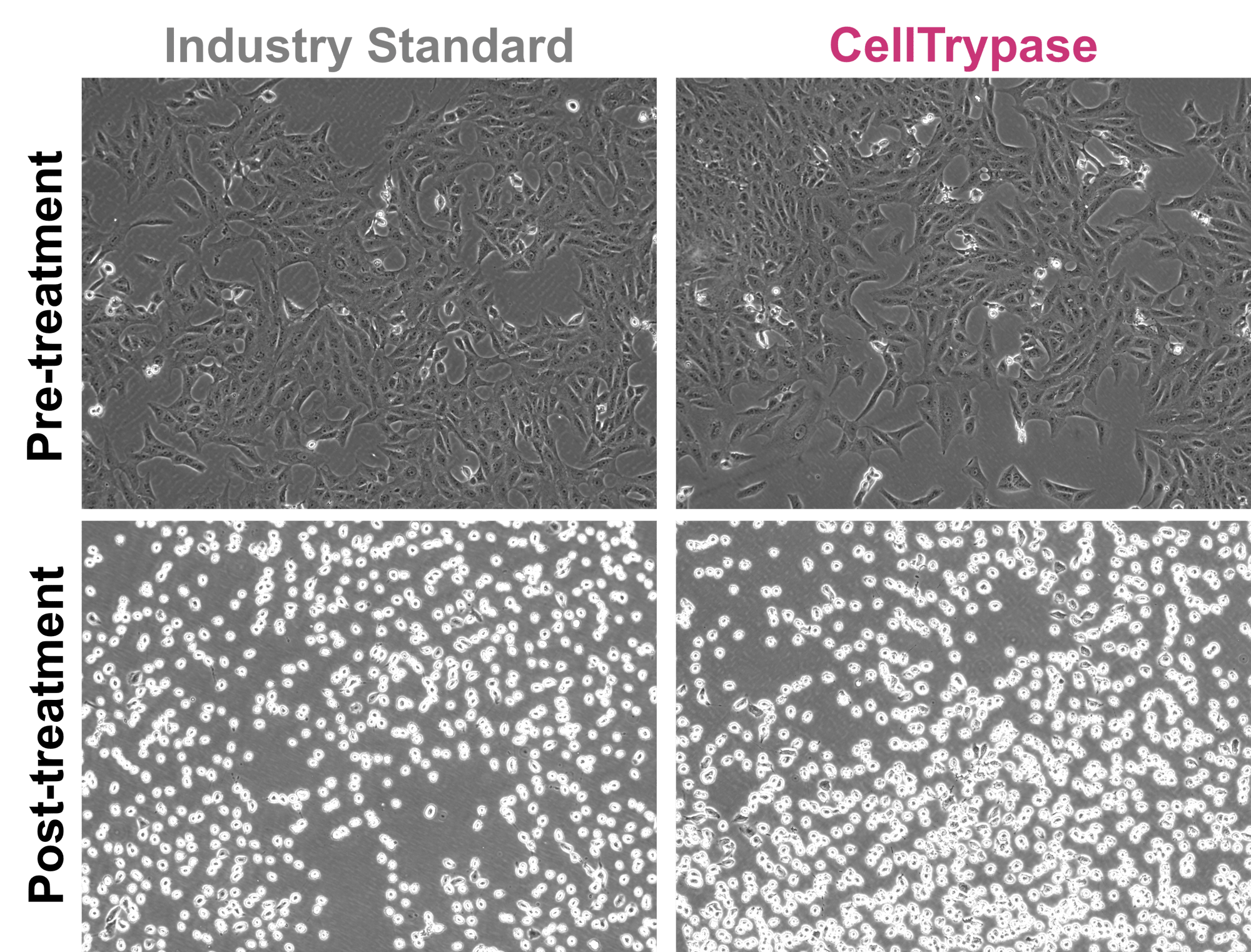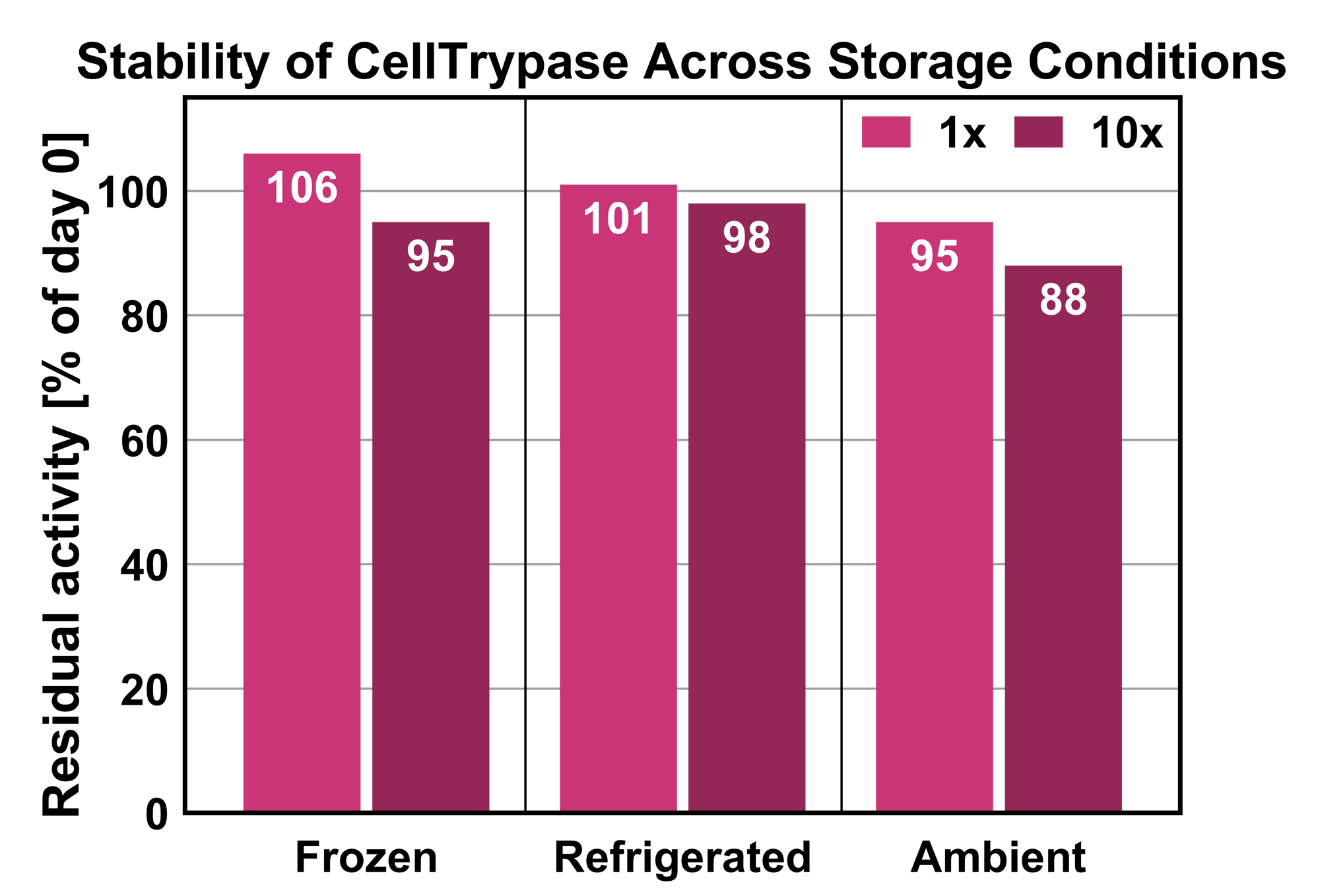CellTrypase - Enzyme Characteristics
CellTrypase is designed as a direct alternative to conventional cell dissociation enzymes, including porcine trypsin, fungal trypsin-like enzymes, and other recombinant animal-derived proteases.
Proven Performance
CellTrypase has been validated across key cell lines used in viral vector and vaccine production (Table 1). The enzyme enables efficient dissociation, high cell viability, and robust recovery, making it a high-quality alternative to available trypsin-based reagents.
CellTrypase shows similar dissociation kinetics to porcine trypsin as well as comparable cell replating, proliferation kinetics, and long-term maintenance.

Table 1: Dissociation of key viral vector and vaccine production cell lines using 1x CellTrypase.
✓ = CellTrypase matches or exceeds the performance of the current industry standard enzyme (control).
CellTrypase demonstrates comparable dissociation kinetics to currently available trypsin-like enzyme solutions with matched yield, recovery and long-term culture proliferation (Table 1, Fig. 1).
CellTrypase is suitable for direct 1:1 substitution in existing cell culture protocols.
Find additional CellTrypase performance data on key biopharma production cell lines and iPSCs in our Application Note.

Fig. 1: Microscopy of Vero cell dissociation
Representative images before and after treatment with CellTrypase or the industry standard (1x working solution). Captured using EVOSTM M5000 (10x objective).
Convenient Handling
CellTrypase is designed for ease of use in regulated bioprocessing environments. Its liquid format, robust stability, and simple inactivation make it a convenient and reliable choice for cell culture workflows.
Available as:- Ready-to-use 1x solution
- 10x concentrated stock: can be diluted or used undiluted for fast detachment of strongly adherent cells
Simplified Storage & Transport
CellTrypase offers superior stability as a sterile filtered, liquid solution compared to porcine trypsin, supporting consistent performance in GMP-compliant manufacturing and research workflows. The stability profile supports:
- Long-term stability at 2–8 °C for storage
- Shipping at ambient temperature
without compromising enzymatic activity or product quality.
Real-time stability data (Fig. 2) confirm that CellTrypase delivers consistent enzymatic activity when stored at 2–8 °C. In addition, CellTrypase remains stable under frozen and ambient conditions for at least 6 months.
This flexibility simplifies logistics, reduces costs, and ensures consistent performance in GMP-compliant workflows.

Fig.2: Activity of CellTrypase 1x solution and 10x stock under frozen, refrigerated and ambient storage conditions over 6 months.
Easy Inactivation - No Inhibitor required
After cell detachment, CellTrypase can be inactivated by dilution with standard culture medium or buffer. No additional reagents such as soybean trypsin inhibitor are required.
-
Quenching: Add fresh medium (serum-free or serum-containing)
-
Optional removal: Centrifuge and resuspend cells in fresh medium if complete removal is required
This simplifies downstream processing and reduces the risk of unwanted effects from residual inhibitors.
Quick Protocol
CellTrypase is supplied as a ready-to-use, sterile filtered liquid enzyme and integrates seamlessly into standard cell culture workflows.The following protocol outlines typical use for adherent cell dissociation:
-
Pre-warm enzyme and medium
-
Rinse cells with PBS
-
Add CellTrypase (approx. 1 mL per 25 cm²)
-
Incubate until detachment (37 °C or RT)
-
Quench with fresh medium
-
Optional: Pipette to assist detachment or centrifuge to remove enzyme
Product Specification
In order to ensure a constant and high-quality level for CellTrypase, each batch must fulfill the in-house acceptance criteria for the parameters listed below.
| Parameter | Method | Specification |
|---|---|---|
| Appearance | Visual Inspection | Clear, transparent to slightly colored solution |
| Activity | Photometric1 | (1x) 0.6 kU/L – 1.2 kU/L (10x) 6 kU/L – 12 kU/L |
| Identity | Determination by HPLC | Identity complies |
| Purity | Determination by HPLC | ≥ 95 % |
| pH | Ph. Eur. 2.2.3 | 7.1 – 7.6 |
| Osmolality | Ph. Eur. 2.2.35 | 270 – 320 mOsm/kg |
| Endotoxin level | LAL-Test Ph. Eur. 2.6.14/USP <85>, Method D |
(1x) ≤ 1 EU/mL (10x) ≤ 10 EU/mL |
| Mycoplasmas | qPCR Detection Assay acc. to Ph. Eur. 2.6.7 | Negative |
| Sterility testing | Ph. Eur. 2.6.1/USP <71> | Pass |
1 Unit-Definition: One unit (U) corresponds to the amount of CellTrypase that forms 1 μmol p-Nitroaniline per minute at 37 °C from 8 mM L-AAPA at pH 8.0.
Stability & Storage Conditions
CellTrypase can conveniently be stored at 2-8°C ± 5 °C. The enzyme solution should be protected from light.
Packaging Information
CellTrypase is filled into non-pyrogenic PET containers with HDPE screw caps. Each unit is secured with a tamper-evident shrink seal to ensure product integrity. The primary packaging complies with USP Class VI and 21 CFR requirements for pharmaceutical use.
Get in touch with our CellTrypase Expert Team!

Vaishnavi Devarakonda
CellTrypase Sales

Melissa Rangel
CellTrypase Sales
Need support? Contact me!

Sedef Özyürek-Heistermann
CellTrypase Sales
Need support? Contact me!


